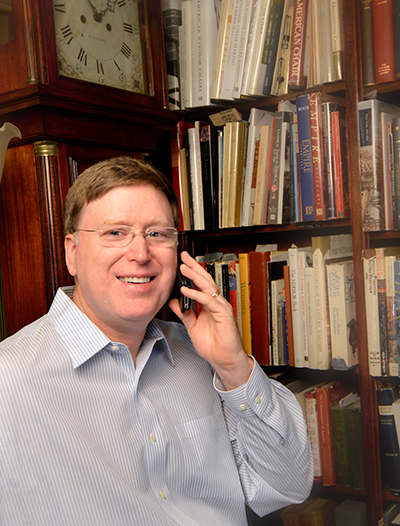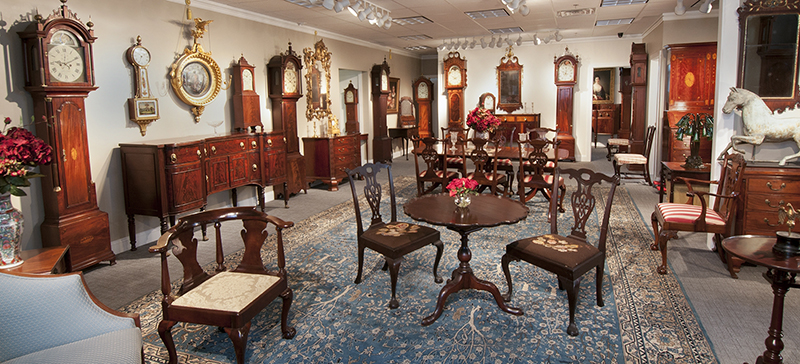A private dealer for four decades, Gary Sullivan came to national attention in 2009 as a co-author of Harbor & Home: Furniture of Southeastern Massachusetts, 1710–1850, the Winterthur-sponsored book and exhibition. On August 13, Sullivan opened his first public showroom in more than 20 years, at 1 Wattles Street in Canton, Mass., 20 minutes south of Boston and less than a mile off of I-95. Offering an extensive selection of formal Eighteenth and Nineteenth Century American furniture and clocks, the 4,000-square-foot gallery is a welcome addition to the collecting landscape and proof that not all new initiatives are online.
How did you get into the antiques business?
When I was a senior in high school, I walked into a local shop and asked if anything needed to be fixed or refinished. I quickly realized that I could buy and sell for my own account. I worked my way up from there. I wanted to be like Henry Postar, the legendary Boston area dealer. He got into great estates and was knowledgeable in many different areas. His shop in Brighton was a hotbed of activity. He was very kind to me as I was learning the business.
Why are you opening a shop, when so many have closed?
We only do one show, the Delaware Antiques Show. It’s terrific, but we’re limited in what we can bring. We’ve had a significant online presence for almost ten years. It generates lots of traffic, but only a fraction of our inventory is on the site. Properly photographing, describing and posting the items is so time consuming that I’d have to hire another full-time employee to post everything. One aim of our shop, beyond attracting collectors and curators, is to provide a place where designers can conveniently bring clients to see a range of upscale, formal pieces. I looked a long time for the right place. I wanted a good-size gallery right off the highway.
Your gallery recalls the old Israel Sack, Inc. Is demand for formal furniture on the upswing?
I wouldn’t say it’s on the upswing, but there are still people with a strong sense of history and culture who want to furnish their homes with fine, traditional furniture. The audience is definitely out there. The market is not strong at the entry level. That’s pretty tough. But at the higher end, where I’m dealing, there’s demand.
How are your new premises arranged?
We have two large galleries and two small ones. We mixed things from different periods and styles because that’s what people seem to do today. Many of our sales are to people who are accenting with traditional antiques. We’ve had a great response so far. About 160 people attended our opening party. Our sales included a Simon Willard tall case clock, which we presented for the first time. The new gallery is open weekdays by chance or appointment.
How do you find time to research and write?
It’s a difficult juggling act. I couldn’t do it without my associate, Matt Buckley. He runs much of the day-to-day operation. I’m working on two books at the moment. I hope to have Musical Clocks of Early America: 1730–1830 out in time for Americana Week in January. It’s nearly done and originated with the exhibition I organized with Kate Van Winkle Keller at the Willard House and Clock Museum in North Grafton, Mass., in 2013. I’m also participating in the Rhode Island Furniture Project, orchestrated by Patricia E. Kane, the Friends of American Arts Curator of American Decorative Arts at Yale University Art Gallery. Pat and I wrote an essay on clock making and I compiled entries for 13 clocks. A companion exhibition is scheduled to open at Yale University Art Gallery in August 2016. I have just started another research project on the Newburyport, Mass., cabinetmaker Joseph Short.
Aren’t you also a tech entrepreneur?
I co-founded gemr.com, a website for collectors. We launched in mid-January. Young people have jumped all over the site. For the moment, the emphasis is on things that interest them. What’s unique about the site is that you can post pictures and discuss items without necessarily buying or selling. We want people to share information. You can “favorite” things, and follow individuals and institutions. It has a very social aspect to it — like Pinterest, Facebook and eBay combined. Some historical societies and museums are already participating and have posted some wonderful items. For several months we’ve been working on building and refining the site. Our next step will be to introduce it to traditional collectors of antiques, generally older and less tech-savvy.



